- Kia ora
- Women in construction
- Opening of the shared path southern section
- PP2Ō earthworks
- Raranga (weaving) on Bridge 4
- Paving our way
- Upcoming construction milestones
- SH1 Ōtaki to Levin safety improvements
 Kia ora
Kia ora
June and July have certainly proved challenging for our construction team with plenty of wet days and very few dry days. Our construction programme does have an allowance for wet weather which means we continue to make reasonable progress relative to what we expected. As an example, the earthworks team have finished the bulk of the work on the Expressway between the Makahuri (formerly Marycrest) Rail Overpass and Te Kowhai Road, including the wetlands and top-soiling batters. In total our team moved around 10,000 m3 of topsoil and structural fill in the last month.
Wetlands play a critical role in any healthy environment. It’s why we are so proud that we are enhancing existing wetlands and constructing new ones along the length of the Expressway. Not only do they filter the water flowing through them, they also act like a sponge – absorbing water in times of flood and releasing it during drier periods.
Once the earthworks are complete and the subgrade (layer below the pavement) has dried out sufficiently, we can start placing and cement stabilising the sub-base – first layer of the pavement made up with aggregate (65mm diameter stone). After we’ve stabilised the subbase and it’s gained sufficient strength, we start laying the asphalt. The first two layers provide the strength and durability with the final layer of EMOGPA (Epoxy Modified Open-Graded Porous Asphalt) providing a quieter running surface. While we can continue with the construction of the first two layers of asphalt through winter, except on wet days, the EMOGPA needs warmer weather and as it’s the final icing on the cake, we want to leave it until right at the end so we’re minimising the amount of construction traffic travelling over it.
The combination of asphalt layers is referred to as Deep Lift Asphalt and while it is more expensive than traditional granular pavements, it has a longer life, performs far better under heavy traffic conditions and requires less maintenance. It also provides a smoother surface than chip-seal with a subsequent reduction in tyre noise.
As always, we are aware of the disruption that large construction projects can cause and try and be mindful of how our work may affect the public. We’re also conscious of the impact that the heavy rain that we’ve been experiencing has on our temporary roads. Our team have been responding quickly to any potholes that appear and we really appreciate your patience as we address these as quickly as possible. It’s also worth noting that sometimes we carry out a temporary repair with a more permanent repair completed as soon as we get a dry period.
If you need any further information on the PP2Ō Expressway Project please visit our website www.nzta.govt.nz/pp2o(external link) (where you can sign up for digital updates), call us on 0800 PP2O INFO or email pp2o@nzta.govt.nz
Ngā mihi,
Chris Hunt, Project Director
Women in construction
Women are making their mark in all areas of the construction industry and it is no different within the PP2Ō Expressway project. In fact, our male staff working on PP2Ō believe the construction industry needs more women. Our female colleagues have a well-earned reputation for being punctual, reliable and going the extra mile.
Recently, Ōtaki College media studies students visited our site to interview and film some of the female staff. Their stories are truly inspiring and show that the issues faced by women in construction are probably no different than any other industry.
Opening of the shared path southern section
We’re very pleased to announce that the section of shared path between Te Kowhai and Te Hapua Roads will be opened to cyclists and pedestrians by the end of August.
We’re kindly asking equestrians to be patient and keep their horses off the path until the grass has had time to grow. If the horses go on too soon, their heavy hooves will cut up the surface and we risk having to reclose the pathway while it is relaid.
We expect that the bridle path will be open later in the summer, and we thank all our lovely equestrians for their patience and understanding in the meantime.
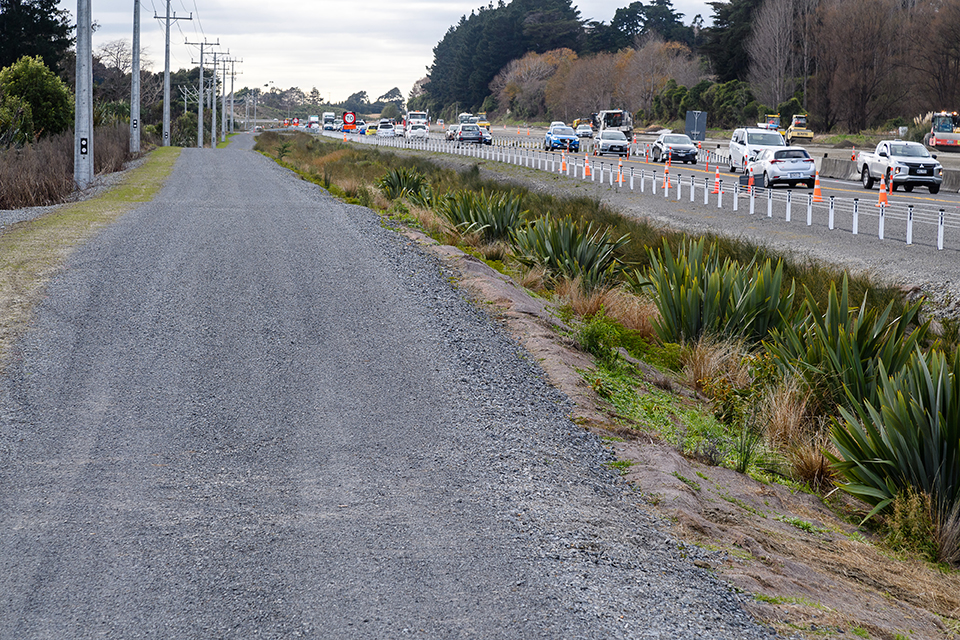
Shared path at southern end of alignment near Te Kowhai Rd.
PP2Ō earthworks
The earthworks team has recently finished the bulk work on the section from the Rail Overpass, opposite Makahuri in Te Horo (formerly the Marycrest Catholic Girl’s School) to Te Kowhai Road, Peka Peka. The earthworks also included wetlands and topsoiling batters.
“We are currently busy constructing all the underground drainage and utility lines to enable us to complete the remaining subgrades, which will allow the subsequent pavement activities, such as placing the sub-base and the asphalt layers,” says Fletcher’s Civil Manager Richard Rakovics.
“We have completed the subgrades between Te Hapua and Te Kowhai Road and our next focus area is the section between the Rail Overpass and Te Hapua Rd. The earthworks activities including subgrading are highly weather dependent, so we are hoping for a sunny August after a soggy June & July.”
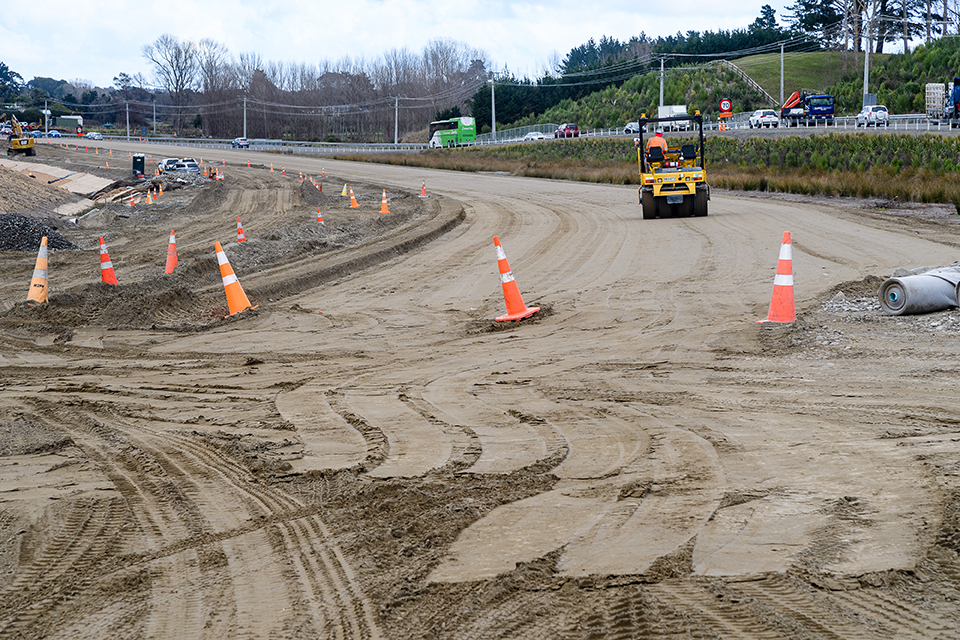
Site just south of Mary Crest.
Raranga (weaving) on Bridge 4

At the Moutere Hanganoaiho land block, underneath Rāhui Road bridge, there is a piece of bridge artwork titled Raranga (weaving). It shows a central tukutuku or taniko pattern surrounded by raupo (bulrush) and harakeke (flax), which are both traditionally used for weaving.
The taniko pattern at the centre of the artwork is an example of the metaphorical union between people and land with Papatūānuku (mother earth) often named after parts of the human body. This taniko piece is representative of Te Tuarātapu-o-Te Rangihaeata (the sacred backbone of Te Rangihaeata), also known as the Tararua Ranges. The Ranges were named after an important Ngāti Toa chief, Te Rangihaeata, to commemerate the peace arrangement between the Ngāti Toa and Ngāti Kahungunu tribes. The range became the dividing line between Ngāti Toa on the west and Ngati Kahungunu on the east. This view looks along the ridge between Aokaparangi and Mt Hector.
For Māori, the fan-shaped Harekeke that is depicted in this artwork is traditionally used as a metaphor for whānau. The rito, or inner shoot, is likened to a child and never removed during harvesting, as a family must protect its offspring to survive. The awhi rito, seen as mātua (parents), are also not harvested and stand on each side of the rito to protect it. Only the outer leaves, likened to extended family members, are harvested.
The artwork depicted in this bridge symbolises the importance of connectivity. Like the raranga (weaving) depicted in this bridge artwork, Te Atiawa Ki Kapiti; Ngāti Raukawa Ki te Tonga and Ngāti Toarangatira, through the formation of the A.R.T confederation, have shown the strength and versatility of being woven together.
In the early 1800’s, three iwi, with interlinking whakapapa (family trees), migrated from their homelands and settled in the area between Palmerston North and Nelson. Early squirmishes were resolved through diplomacy, which allowed a productive union known as the A.R.T (Atiawa, Ruakawa and Toa) Confederation.
The A.R.T confederation has developed four guiding principles that they believe are central to their continuation:
- The people are our wealth - to develop and retain
- The Māori language is a taonga - to halt its decline and revive
- The Marae is our principal home – maintain and respect it
- Self determination.
The formation of the A.R.T confederation has resulted in initatives such as the construction of Rangiātea church, Raukawa Marae, The Otaki Māori Racing club and Te Wanaga o Raukawa (previously Otaki Māori Boys College) which has seen an increase in academic achievement and a strong revival of te reo (Māori language) among A.R.T members.
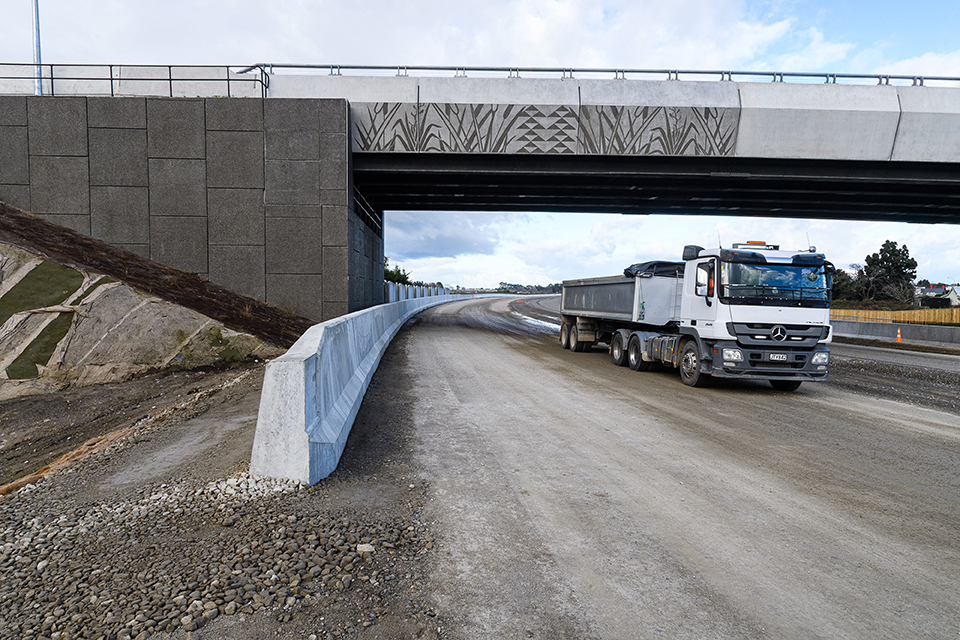
Gracing the Expressway on the side of the Rahui Road Bridge is the artwork titled Raranga.
Paving our way
We are currently paving the first two layers of asphalt north of the Makahuri Rail Overpass. For those interested in the technical details, the three layers of asphalt for the PP2O Expressway consist of AC20, AC14, and EMOGPA (Epoxy Modified Open-Graded Porous Asphalt). EMOGPA is a new product that lasts much longer than other surfaces. It reduces road noise and water spray and is expected to last up to 30 years – that’s four to five times longer than standard products. Other benefits of EMOGPA include:
- A smoother surface for drivers
- Ability to drain water from the road surface during heavy rain
- Ability to withstand heavier traffic volumes
- Lower operational noise
- Fewer disruptions to road users for maintenance and resurfacing
The Peka Peka to Ōtaki Expressway will be a fantastic addition to the Kāpiti Coast, strengthening our district’s connections to the north and the south. With works advancing and our sites becoming more visible, please slow down, stick to the speed limits, and allow a little extra time for your travel.
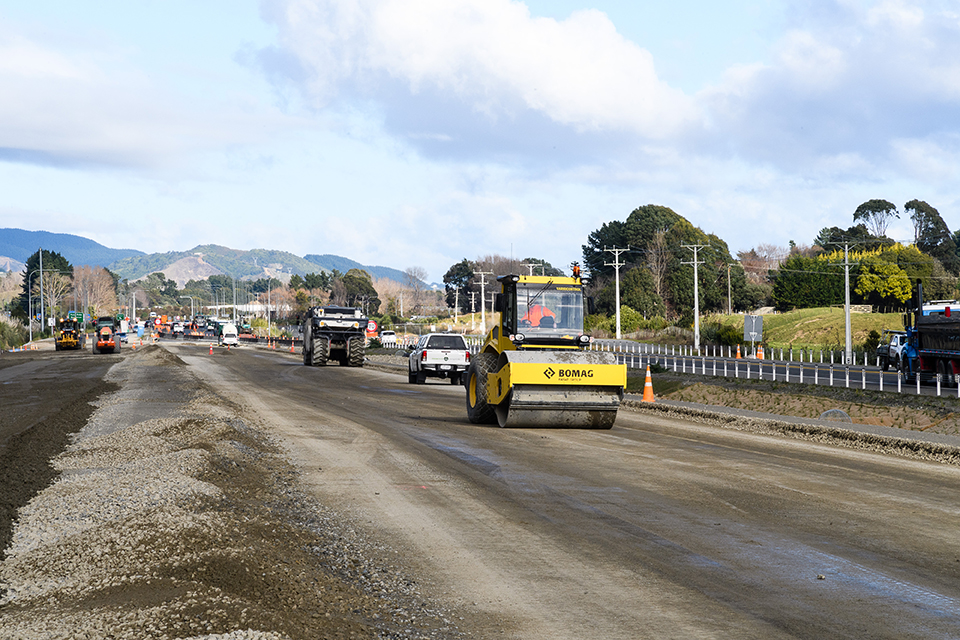
Paving the layers of asphalt.
Upcoming construction milestones
Northern area update
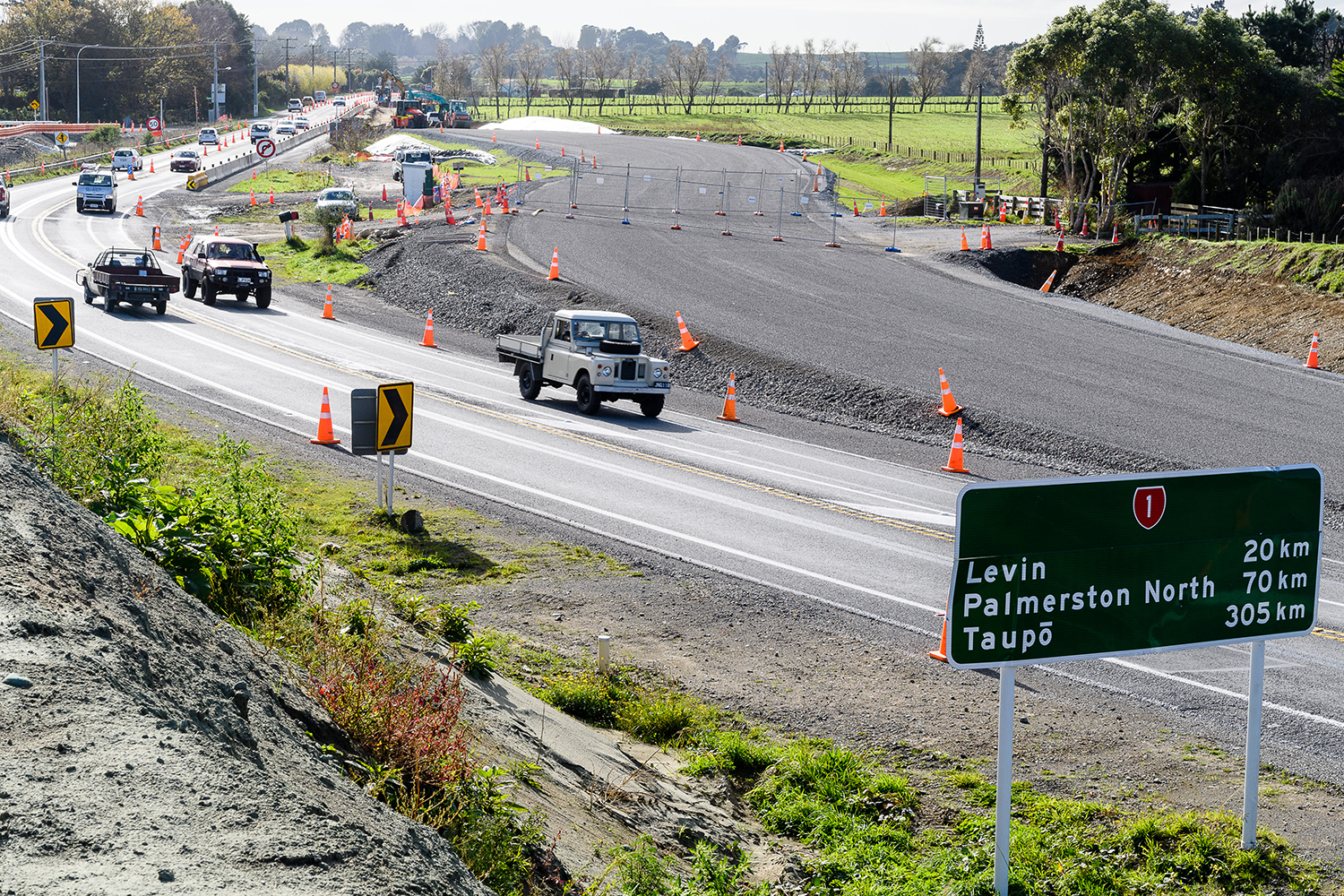
Pavement works to the northern tie-in are underway and will continue until early / mid-August, when southbound state highway traffic will be switched onto a temporary road, to allow tie-in works to be completed. Stabilised subbase works will continue north of Bridge 2, including the Expressway On & Off ramps.
Central area update
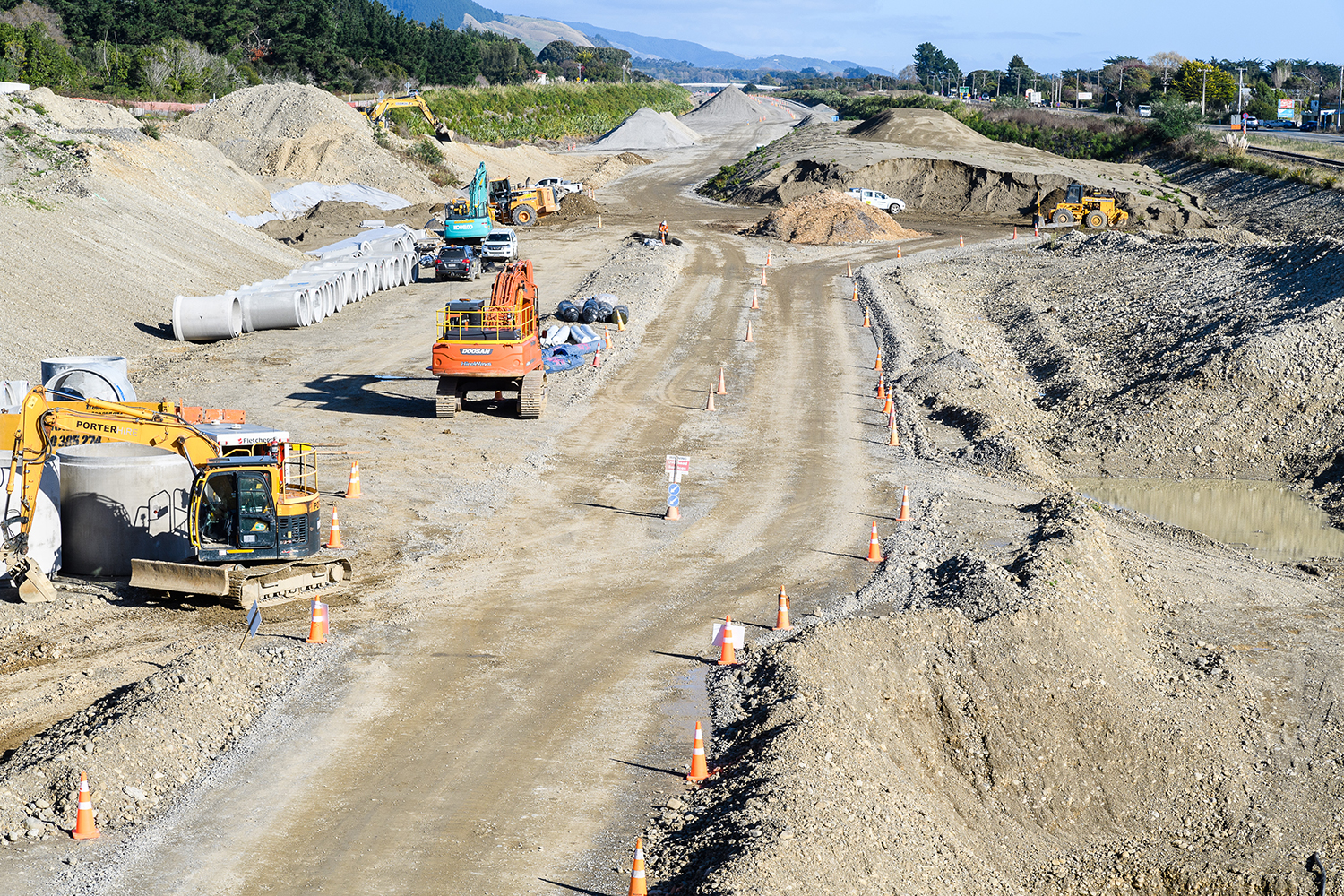
In the next month the finishing works to the new Ōtaki River Bridge will be completed, including the shared path architectural handrail. In the area between Ōtaki Gorge Road and Makahuri, there will be continued completion of stabilised subbase and asphalting works followed by the installation of barriers.
Southern area update
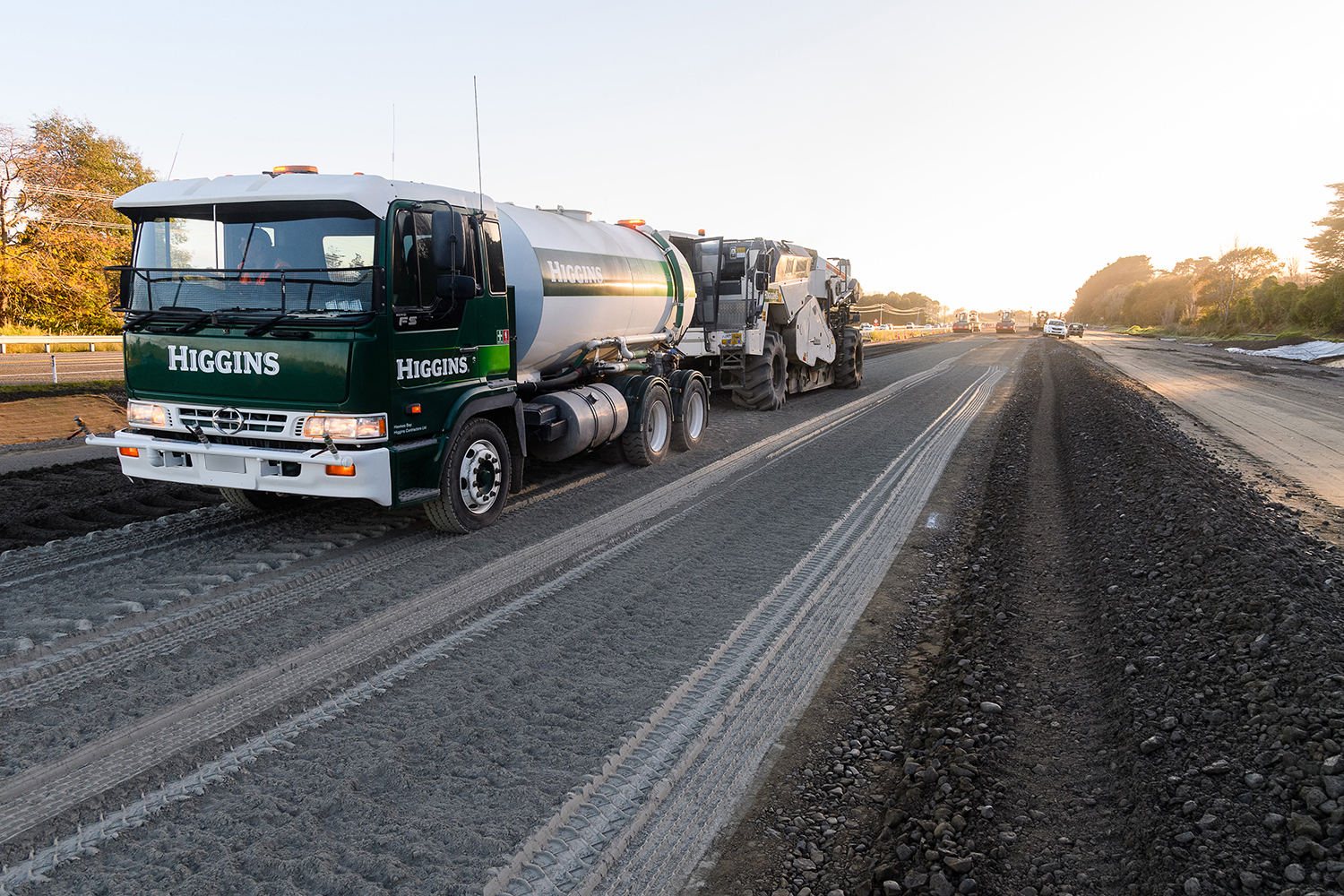
Towards the end of August, the last of the bridge deck pours on the Makahuri Rail Overbridge will occur, with barrier installation following in September and October. Stabilised subbase construction will continue north from the adjacent Te Hapua Rd to the local road underpass. Later in the month, the project will open the new section of shared path between Te Hapua Rd and Te Kowhai Rd.
SH1 Ōtaki to Levin safety improvements
Waka Kotahi NZ Transport Agency is looking at making State Highway 1 between Ōtaki and Levin safer. When Transmission Gully and the Peka Peka to Ōtaki expressway are completed, drivers will travel from Wellington to north of Ōtaki on dual-lane, median separated highways. The proposed safety improvements are designed to transition drivers safely from this environment through to the single-lane SH1 to the north. Traffic will travel first on median separated road and then through stretches with wide centrelines, and a roundabout is proposed at the SH1/SH57 intersection.
Locals know their roads, so we want to know what you think about proposed safety improvements and current speed limits in the area.
Find out more and your say on our project page:
Have your say before 11 August 2021.